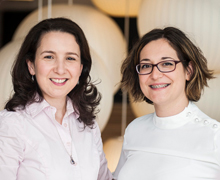Therapies for Pediatric Epilepsy and Brain Malformations
Stem cell-based models for studying epilepsies associated with mTOR mutations
Technology Overview
 Drs. Ghayda Mirzaa and Filomena PirozziDr. Ghayda Mirzaa is a pioneer in identifying mutations linked to brain disorders such as focal cortical dysplasia, a leading cause of pediatric epilepsy that is resistant to treatment. Children with focal epilepsy can have 50 or more seizures a day and are at risk of early death.
Drs. Ghayda Mirzaa and Filomena PirozziDr. Ghayda Mirzaa is a pioneer in identifying mutations linked to brain disorders such as focal cortical dysplasia, a leading cause of pediatric epilepsy that is resistant to treatment. Children with focal epilepsy can have 50 or more seizures a day and are at risk of early death.
Dr. Mirzaa and colleagues discovered that some children with focal epilepsy have mutations in the mTOR pathway that controls cell growth and metabolism. A number of cancer drugs that target the mTOR pathway are in clinical use or development. Dr. Mirzaa is studying if these drugs could be an effective treatment for children with focal epilepsy and mTOR mutations.
To study epilepsy and other brain disorders, Dr. Filomena Pirozzi in the Mirzaa group is leading development of stem cell-based models. Drs. Mirzaa and Pirozzi convert skin cells from patients into induced pluripotent stem cells (iPSCs). The iPSCs have the genotype of the patient donor and the capabilities of stem cells, including the ability to differentiate into multiple tissues. Drs. Mirzaa and Pirozzi induce the iPSCs into neuronal tissue grown as traditional two-dimensional cultures or as three-dimensional brain organoids, which are only a few millimeters across but have many of the specialized tissues of brains.
The Mirzaa group is using the patient-specific neuronal cells and organoids to characterize mTOR-related epilepsy. They are studying if traits such as proliferation, signaling, and cell organization and protein expression are normal or abnormal. By matching patient genotypes to phenotypes, these studies could discover new druggable targets in the mTOR pathway.
The group is also creating panels of patient-derived neural models for systematic, parallel, high-throughput testing of mTOR-targeting drugs. They are assaying the effects of drugs alone and in combination, because when one part of the mTOR pathway is inhibited, cells compensate with adjustments in other parts of the pathway. Simultaneously applying agents that target the upstream, middle, and downstream segments of the pathway will show if combination therapy increases the effectiveness of mTOR-targeting medicines. Dr. Mirzaa's group can make custom adjustments to the models using CRISPR gene editing.
Seattle Children's Hospital has one of the country's largest patient populations with pediatric epilepsy. Drs. Mirzaa and Pirozzi are interested in partnerships around drugs that target the mTOR and related pathway to study them in these stem cell models.
Stage of Development
- Pre-clinical ex vivo
Partnering Opportunities
- Collaborative research opportunity
- Sponsored research agreement
- Consultation agreement
- Tissue sample access
- High-throughput screening
Publications
- Pirozzi F, Nelson B, Mirzaa G. From microcephaly to megalencephaly: determinants of brain size. Dialogues in clinical neuroscience. 2018 December; 20(4):267-282.
- Alcantara D, Timms AE, Gripp K, …. Mirzaa GM. Mutations of AKT3 are associated with a wide spectrum of developmental disorders including extreme megalencephaly. Brain. 2017; 140: 2610-2622.
- Mirzaa G, Campbell C, Solovieff N et al. Association of MTOR mutations with developmental brain disorders, including megalencephaly, focal cortical dysplasia, and pigmentary mosaicism. JAMA Neurology. 2016;73: 836-845.
- Mirzaa G, Conti V, Timms A et al. Characterisation of mutations of the phosphoinositide-3-kinase regulatory subunit, PIK3R2, in perisylvian polymicrogyria: a next-generation sequencing study. The Lancet Neurology. 2015;14(12):1182-1195.
- Mirzaa G, Parry D, Fry A et al. De novo CCND2 mutations leading to stabilization of cyclin D2 cause megalencephaly-polymicrogyria-polydactyly-hydrocephalus syndrome. Nature Genetics. 2014;46(5):510-515.
- Zhang M, Ngo J, Pirozzi F, Sun YP, Wynshaw-Boris A. Highly efficient methods to obtain homogeneous dorsal neural progenitor cells from human and mouse embryonic stem cells and induced pluripotent stem cells. Stem Cell Res Ther. 2018;9(1):67.
Learn More
- Ghayda Mirzaa, MD
- Filomena Pirozzi, PhD
To learn more about partnering with Seattle Children’s Research Institute on this or other projects, email the Office of Science-Industry Partnerships.